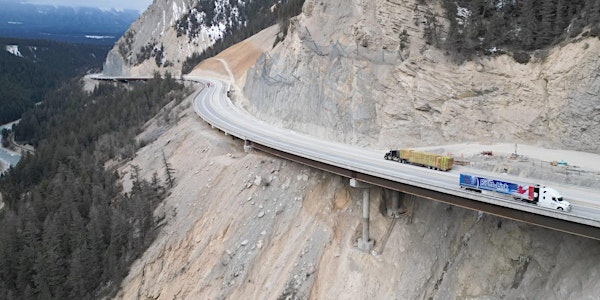
Kicking Horse Canyon Highway Improvement Project
Join us to learn more about the upgrades to the Kicking Horse Canyon Highway
Date and time
Location
Online
Refund Policy
About this event
- 1 hour 30 minutes
The Kicking Horse Pass extends 80 kilometres through the Rocky Mountains between Golden, British Columbia and Lake Louise, Alberta, and is among the most breathtakingly scenic stretches on the Trans-Canada Highway (Highway 1). Both the Trans-Canada Highway and the Canadian Pacific Railway run through the Canyon, supporting the movement of national road and rail-based goods and tourism. The Kicking Horse Canyon section of the Trans-Canada Highway – between Golden and Yoho National Park – was originally constructed in the mid-1950s with the Yoho (5-mile) and Park (10-Mile) bridges completed in 1956.
The Kicking Horse Canyon Phase 4 (KHCP4) design build project delivered improvements to 4.8km of the existing Trans-Canada Highway east of Golden, BC. This was the last and most difficult highway section in the canyon to receive improvements in what has been a 25 year program. The treacherous section of roadway crosses a series of unstable slopes, active landslides, large ravines, and avalanche and rockfall paths. As part of the design team for the Contractor, BASIS Engineering Ltd. provided a significant portion of the structural, geotechnical and construction engineering.
A key project objective was to improve the safety and stability of the roadway. The conventional solution to improve roadway stability on steep embankments is downslope retaining walls which support the roadway with stabilization pipe piles in front of the wall, often with additional horizonal steel rock anchors. The extreme conditions at this site were found to require very close pile spacing, and the access for heavy piling and anchor installation equipment was very difficult. The CP railway is downslope of the project, creating additional safety concerns for possible triggering of rockfall onto the rail.
An alternative structural solution was proposed by BASIS for a Viaduct using accelerated bridge construction techniques. The design was adopted for a total of nine Viaduct structures totalling over 1.8km of highway length, which was significant portion of the entire project.
Bruce Hamersley was the lead designer for the viaducts, and James Williams was the lead geotechnical engineer for the eastern third of the project.
Bruce Hamersley has 37 years of engineering experience with a focus on bridge design, soil-structure interaction and construction engineering. His diverse design background includes design management of large transportation projects as both the Owner’s Engineer and Contractor’s designer, highway and railway bridge designs, seismic retrofit and rehabilitation of major bridges and construction engineering for bridge erection.
James Williams is a geotechnical engineer with expertise in the analysis and design of bridge foundations, dams, tunnels, heavy industrial buildings and transportation infrastructure. His field experience includes planning and supervision of site investigations, geotechnical instrumentation installation and construction monitoring. James also has experience in slope stability, settlement analysis, seismic analysis, liquefaction assessments, soil-structure interaction, tunnel design, shallow foundation design and pile design.